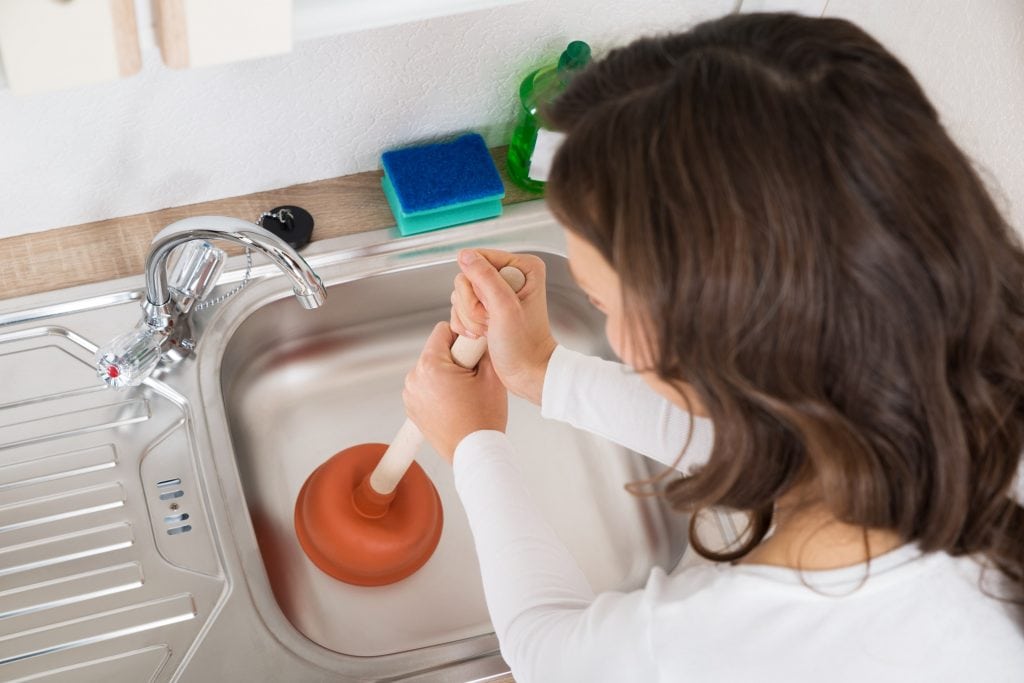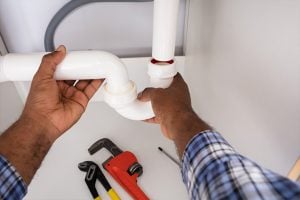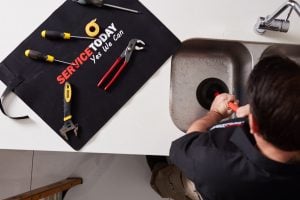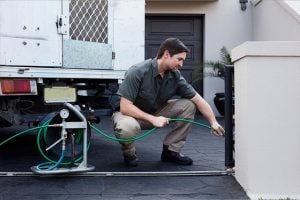Blocked drains are a common problem in Australian homes and how to unblock a drain is a very common question. Even if you haven’t yet experienced the problem yourself, it’s more than likely that you know someone who has.
If left unattended, these blockages can lead to more serious problems including structural damage, flooding, unsanitary environments, damage to carpets, floorboards, furniture and appliances and even irreparable drain damage. If you are a tenant, you need to speak to your Real Estate agent or landlord. They are responsible for this type of repair. For more information, look at the tenants union site in your state. It is usually located on the repairs and maintenance page like here in NSW in VIC.
Before we get into the nitty gritty of unblocking your drain, let’s look at why this happens in the first place. There are quite a few common reasons for drain blockages and it is with taking a little bit of time out of your day to learn a bit more about this problematic issue. Knowing the common signs to look out for, how drains can get blocked to begin with and what you can do to avoid it happening again, may just prevent you from going through this again in the future.
Symptoms of a Blocked Drain
Some of the most common signs of a blocked drain include water draining slowly, bad odours and gurgling sounds coming from the pipes. If left untreated, drain issues will most definitely become worse over time. So the sooner you act on any signs that there is a problem with your drains, the better!
How does a drain become blocked?
A drain will often become blocked due to an obstruction by foreign objects, such as food scraps, jewellery, soap, leaves, plants, tree roots, hair, grease or fat and toiletries. Any of these, and many more items, can easily create a block inside your drain. Also the age and condition of the pipes can be a major contributor to causing a blockage.
How to avoid future blockages
Even if you have successfully managed to clear a blocked drain, it is important that you make an effort to minimise the risk of the block reoccurring. Prevention is always better than cure. For example, if you don’t already use a drain protector for your kitchen sink, consider purchasing one to help prevent any unwanted objects (like the items we mentioned above) from blocking up your drain. There are other temporary and permanent professional solutions for bigger blockages or damage. This type of damage may be caused by things like tree roots or worn out and cracked pipes for example. To find out more about these larger issues, it is best to speak to your local plumber.
There are a number of fairly simple, uncomplicated methods and tools you can use to unblock a drain yourself. And the good news is, it is not always as difficult as some might think. Now let’s get down to it!
The following are some of our great tips and tricks of the trade. Helping you to know more about how to unblock a drain, DIY style.
Here are simple techniques to clear a Blocked drain on your own:
1. Boil some water and pour it down the drain!
This basic method can help break down any grease or soap that may be blocking your drain, helping to clear the obstruction. However, this method alone may not work in cases where a serious blockage has been building up over time. Nevertheless, it could partially clear the drain if you use it in combination with some other techniques mentioned below.
2. Try using a plunger
Let’s start simple. If you are experiencing problems from a blocked kitchen drain, plungers can come in handy. If you don’t have a plunger, you can pick one up at most local hardware stores and even some supermarkets. Once you have your plunger, you are ready to try our next ‘how to fix a blocked drain” tip. To use a plunger, first remove the drain stopper, then use a wet sponge or rag to block the overflow hole. Place the plunger so that it securely covers the drain, then fill the sink with enough water to rise halfway up the rubber cup. Then, carefully push the plunger down until it reaches the drain and then sharply pull it up, ensuring that you do not break the suction at any point. Repeat the same procedure a few times. This method is cheap and quick, so it is definitely worth a try!
3. Use a hook – or even make your own!
If you’re unable to reach the blockage by hand, try fishing it out with a piece of wire. Wires are available at most hardware stores, or if you feel adventurous enough, why not swing by a fishing shop! Better still, you can create a simple tool using a wire coat hanger by forming a hook at the end of it. Neat, huh?
4. Use a Plumbers’ Snake (also known as a Toilet Jack or Electric Eel)
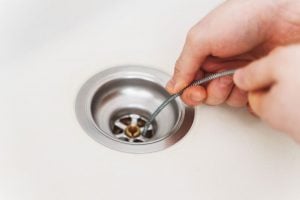
5. Clear it by hand
Okay, so we’re about to get hands-on. It is recommended to wear rubber gloves in this instance. First, remove the drain cover. Then, look inside the drain carefully and see if you can locate the blockage. A torch can be helpful here. If the cause of the obstruction is within easy reach, you can pull it out with your fingers – just make sure to keep the gloves on.
6. Use chemical drain cleaners
Chemical drain cleaners can provide a simple and cost-effective method that gets fast results. When using chemicals, it is important to carefully follow any directions on the packaging. Keep in mind that this method of unblocking a drain can cause damage to pipes, particularly when used too often. However, you should avoid causing damage through excessive chemical use by making an effort to prevent future blockages. You can find strong chemical cleaners in most supermarkets and hardware stores. So why not give it a go!
7. Try using baking soda & vinegar
Baking soda and vinegar are great natural substitutes for harsh cleaning chemicals. Plus, they’re available in every supermarket! Take a break from the hardware store and do something a little more creative this time around. Pour a cup of baking soda into the drain and wait for a few minutes. Then, follow it with a cup of vinegar. Let this sit for a couple of hours so it can melt the blockage. After this, pour boiling water directly into the drain to clear it all out. Many people prefer this method since it is eco-friendly and won’t damage plastic pipes.
If you’ve tried everything and still don’t know how to unblock your drain, it’s probably time to contact a professional plumber. Even though your DIY project didn’t come to fruition, if you now know what is causing the blockage, it’s not a total loss. Give this information to the professionals and save yourself some $ in unnecessary labour costs. By giving this information to your plumber won’t have to spend as much time finding the issue. They can simply get down to diagnosing it.
Why do I need a plumber?
The expert plumbing at Service Today have extensive knowledge and experience regarding all types of drainage systems. Below, they have outlined the following steps that their expert technicians use to unblock a drain.
1. Investigation
Using advanced CCTV drain cameras, expert drainage technicians can position and manoeuvre a camera inside the drain. This technology allows them to accurately locate the problem, with the help of a video monitor placed at ground level. Whether it is stormwater drain clearing or bathroom drain cleaning, CCTV inspection is extremely helpful in determining the best solution to clear any drain.
2. Location
Highly advanced pipe locators can allow technicians to pinpoint exactly where the problem lies. This is done by tracking an electrical signal omitted from the head of the CCTV drain camera. This signal enables them to establish how far along the drain a blockage is, and even tells us the depth.
3. Blockage removal
In addition to CCTV drain cameras and pipe locators, some expert vehicles like the ones at Service Today are fitted with high pressure water jetting equipment for drain cleaning. A high pressure water jet will cut through just about anything in its way. This includes rubble, silt, tree roots and, in some cases, solid matter such as concrete and timber posts.
4. Confirmation
Once the blockage is cleared and the pipe cleaned, drainage technicians will send a camera down the line once again. This ensures the drain is completely clear and that the problem is properly fixed.
5. Recommendation
Of course, just clearing out a blocked drain may not be enough to ensure that it won’t happen again. Technicians need to be upfront and honest with clients when suggesting the best options moving forward. We may suggest periodic drain cleaning, replacing sections of pipe or employing our advanced pipe relining technology. There has been great progress made in the space of blocked drain investigation, detection, diagnosis and repair. When you know advanced technology is involved, it makes it all the better.
Service Today technicians are available to clear blocked drains in Sydney, Melbourne, Adelaide and Brisbane.
Learn more about Service Today’s expert drain clearing process:


